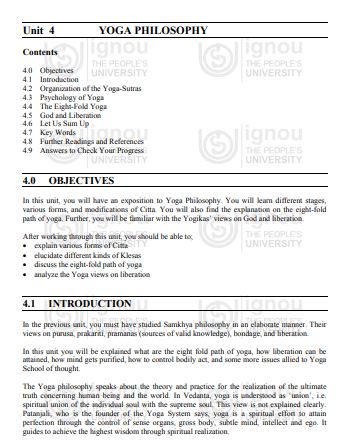‘What Is Yoga Philosophy’ PDF Quick download link is given at the bottom of this article. You can see the PDF demo, size of the PDF, page numbers, and direct download Free PDF of ‘Importance of Yoga Philosophy’ using the download button.
Basic Philosophy of Yoga For Beginner PDF Free Download

Organisation of Yoga Sutras
In the previous unit, you must have studied Samkhya philosophy in an elaborate manner. Their views on Purusha, Prakriti, sramanas (sources of valid knowledge), bondage, and liberation. In this unit, you will be explained what are the eightfold path of yoga, how liberation can be attained, how the mind gets purified, how to control bodily acts, and some more issues allied to the Yoga School of thought.
The Yoga philosophy speaks about the theory and practice for the realization of the ultimate truth concerning human beings and the world. In Vedanta, yoga is understood as ‘union’, i.e. spiritual union of the individual soul with the supreme soul. This view is not explained clearly.
Patanjali, who is the founder of the Yoga System says, that yoga is a spiritual effort to attain perfection through the control of sense organs, gross body, subtle mind, intellect, and ego. It guides us to achieve the highest wisdom through spiritual realization.
Patanjali’s ‘Yoga-sutras’ are the first and foremost systematic and authoritative presentations of yoga in both its theoretical and practical aspects. Followed by Patanjali, Vasys’s “Yoga–bhasya” and Vacavpati Mishra’s ‘Tattva-vaisaradi” are good additions to Yoga philosophy. These two works are treated as commentaries on Yoga-sutras.
The Yoga Philosophy is closely associated with Samkhya philosophy. Yoga presents a practical path for the realization of the self whereas the Samkhya emphasizes the attainment of knowledge of self using concentration and meditation. Thus, it won’t be incorrect to state that yoga is the practice and Samkhya is its theory.
The Gita says that Yoga and Samkhya are the practical and theoretical sides of the same system. Although there are many similarities found between Samkhya and the Yoga system a few dissimilarities are highlighted.
The similarities are; that both schools uphold that liberation can be attained through knowledge. And, to attain this knowledge it requires the power to control body, mind, senses, intellect, and ego. Yoga accepts three pramanas which are agreed by the Samkhya.
These three Pramanas are; perception, inference, and verbal testimony. There are twenty-five metaphysical Principles as viewed by the Samkhya and it is agreed by the Yoga.
The dissimilarities lie when Yoga states that there is only one and Purusa known as the ‘Supreme self’ who is eternal, ubiquitous, beyond time and space. Rejecting this view, Samkhya expresses that there are many Purusas and hence, there is an innumerable number of selves.
Psychology of Yoga In Education
A psychological foundation is a prerequisite to understanding the path of yoga. In other words, a basic understanding of psychology helps to understand the way of yoga in a clear form.
Thus, we need to understand on a priority basis ‘What is the psychology of yoga?’. The most crucial element in the psychology of yoga is citta.
‘Citta’ means the three internal organs as described in the Samkhya philosophy- buddhi or intellect, ahamkara or ego, and manas or mind.
It is the first modification of the Prakriti in which sattva guna dominates rajas and tamas. It is material by nature, but due to nearness or closeness with the Purusa, it acquires consciousness.
But when it relates to an object, it assumes the ‘form’ of that object. This form is called Vrtti or modification. Due to the modifications of Citta, the self knows the worldly objects.
No real or actual modification occurred in the self. However, due to the reflection of the Purusa in the modifications of Citta, there is an appearance of change found in it.
Just as the moon appears as moving in the river and waves of the river appear as luminous, similarly Purusa appears as undergoing modifications and citta appears as conscious due to Purusa’s reflection in it.
When the knowledge of an object is attained the self ceases to exist from the modifications of Citta.
It even detached from the association and aversion to worldly joys and pain. This attachment and aversion is nothing but ‘bondage’.
To get rid of this bondage human beings need to control the modifications of citta.
One can control the modifications of citta only by practicing yoga continuously. In this regard, Patanjali defines yoga as the cessation of the modification of citta.
God And Liberation
The Yoga school while accepting the existence of God explains the salient features of God that are found in the ‘Yoga sutra’.
According to the Yoga Philosophy, God is free from the law of karma, pain, pleasure, joys, and all sorts of worldly attachments.
He is omniscient, omnipresent and omnipotent. In the Yoga Philosophy, God is called ‘Iswara’. He has eternal knowledge and bliss. His existence is beyond all limitations. He is the supreme authority.
What he does, is not for his own sake but only for the sake of the universe Since God is eternal, benevolent, all-mighty, and all-pervasive, he is dissociated from the law of karma.
Therefore, he does not need any kind of liberation. An individual (Jiva) seeks liberation because he/she has to bear the fruits of his/her karmas.
But God is transcendent to everything. Thus, he is detached from liberation. The Yoga school of liberation is named as ‘kevali.
| Author | – |
| Language | English |
| No. of Pages | 14 |
| PDF Size | 0.2 MB |
| Category | Yoga |
| Source/Credits | egyankosh.ac.in |
Download PDF For Yog History, Click Here
Related PDFs
History And Philosophy of Yoga In Education Book PDF Free Download
